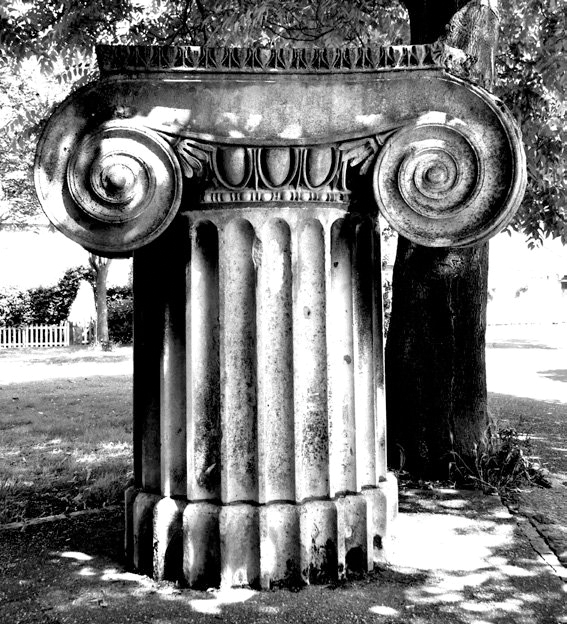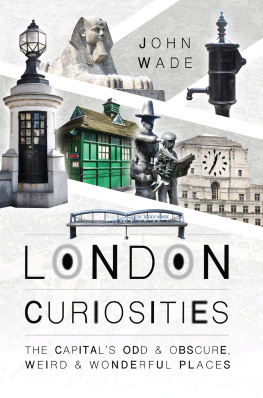
London Curiosities
To three lovely ladies Amelia, Beau and Scarlett my very special granddaughters.
London Curiosities
The Capitals Odd and Obscure, Weird and Wonderful Places
John Wade
First published in Great Britain in 2017 by
Pen & Sword History
an imprint of
Pen & Sword Books Ltd
47 Church Street
Barnsley
South Yorkshire
S70 2AS
Copyright John Wade 2017
ISBN 978 1 47387 911 9
eISBN 978 1 47387 913 3
Mobi ISBN 978 1 47387 912 6
The right of John Wade to be identified as the Author of this Work has been asserted by him in accordance with the Copyright, Designs and Patents Act 1988.
A CIP catalogue record for this book is available from the British Library
All rights reserved. No part of this book may be reproduced or transmitted in any form or by any means, electronic or mechanical including photocopying, recording or by any information storage and retrieval system, without permission from the Publisher in writing.
Pen & Sword Books Ltd incorporates the imprints of Pen & Sword Archaeology, Atlas, Aviation, Battleground, Discovery, Family History, History, Maritime, Military, Naval, Politics, Railways, Select, Transport, True Crime, Fiction, Frontline Books, Leo Cooper, Praetorian Press, Seaforth Publishing and Wharncliffe.
For a complete list of Pen & Sword titles please contact
PEN & SWORD BOOKS LIMITED
47 Church Street, Barnsley, South Yorkshire, S70 2AS, England
E-mail:
Website: www.pen-and-sword.co.uk
Introduction
Every day, thousands of Londoners walk past Cleopatras Needle on the north bank of the river Thames. But how many of those who stroll along the Thames Embankment without giving the monument a second glance, pause to wonder how a 3,000-year-old Ancient Egyptian obelisk came to be here in modern-day London? How many are aware of the dramatic and dangerous journey it made to get to England? Who knows that it actually has very little to do with Cleopatra?
Across the road from Cleopatras Needle, in a small ornamental garden, there is a huge and impressively ornate gateway that leads to absolutely nothing. Nearby, embedded into the wall of the embankment that skirts the river there is a modest memorial to a man who took on a monumental task in the nineteenth century. There is a strong connection between the memorial and the gateway, but what is it?
Up the road, opposite the Houses of Parliament, theres a plaque on a wall dedicated to the man who invented the first traffic lights, which exploded soon after they were erected on this spot. Across Westminster Bridge stands a statue of a lion made of a material whose exact composition has never been revealed. Turn left from here and youll find the last visible remains of an amazing exhibition whose memory today has been all but lost. Turn right and youll come to a bridge where there are tall obelisks with incongruously carved pineapples on their tops. Further on, a statue on the next bridge holds a miniature model of St Pauls Cathedral.
These are all within walking distance of each other. Unsurprisingly, you can find a great many more similar oddities spread out across the 600 square miles of the capital. Some, like those just mentioned, are there in plain sight, easy to see, but with origins that are often difficult to figure out. Others are hidden away in places you would never know about unless you knew where to look.
Who knew that beneath the Albert Memorial there is an undercroft that resembles a church crypt? Or that there are catacombs under Camden? Who would expect to find a lighthouse in East London, sphinxes in South London, dummy houses in West London, or a tomb whose design influenced the iconic red telephone box in North London?
If things like this fascinate you, then you are ready to begin your journey through London, to learn fresh facts about places you might previously have taken for granted and to discover new places, objects, monuments and many other peculiarities that you never even knew existed in this Capital of Curiosities.
Chapter 1
Strangeness in the Streets
Londons streets are full of strangeness. Search them out and items from the past can be unexpectedly found everywhere, from remnants of lost buildings, to chimneys rising from pavements, noses sticking out of walls, unexplained signs attached to buildings and even a Russian tank on a street corner.
* * *
The Last Post
Britains General Post Office headquarters, the countrys first purpose-built post office, was erected at St Martins Le Grand in the City of London between 1825 and 1829. Designed by Robert Smirke, an English architect who was known as one of the leaders of the Greek Revival style, it was an enormous building, 400 feet long and 80 feet deep.
The Grecian style included huge porches flanked by pillars whose tops displayed spiral scroll-like ornamentation, with a triangular pediment topping off the central columns. It was the kind of building that might have looked more at home on a hilltop outside Athens than at the side of a busy London City road.
This magnificent building was closed in 1910 and demolished in 1912. But one small piece still remains. It stands in a street in Walthamstow outside the Vestry House Museum in Vestry Road. The museum, whose building once housed the parish workhouse and which has also been a police station and private house, now contains exhibits that show the history of the London Borough of Waltham Forest.

The General Post Office building, which was demolished in 1912.
The last remains of the old Post Office building might be small in comparison to the entire edifice, but on its own it still dominates the street. It is actually the top part, or capital, of one of the fluted columns that so characterised the look of the old Post Office. When the building was being demolished, this small yet significant lump of stone was purchased by a stonemason named Frank Mortimer, who presented it to the Borough of Walthamstow. It was shifted to its present location in 1954 from its original site in nearby Lloyd Park, today home to the William Morris house and gardens.

The last remains of the old Post Office building, now in a Walthamstow street.
* * *
Unexpected Chimneys
The place for a chimney is on the roof of a building unless of course it is discovered sprouting from a pavement or from the balustrade of a bridge
The Albert Hall chimney
On a small traffic island in the middle of Kensington Gore, no more than a few walking steps south-west of the Royal Albert Hall, there stands a tall, slender brick-built chimney whose height dwarfs the surrounding buildings.
The chimney, whose base is at pavement level, was designed by Major General Henry Young Darracott Scott RE, the principal architect of the Royal Albert Hall. When the concert hall opened in 1871, a large conservatory was attached to its south entrance. This marked the north end of the South Kensington Royal Horticultural Society, which was founded in 1804 to allow members to present papers on horticultural activities and discoveries.


















